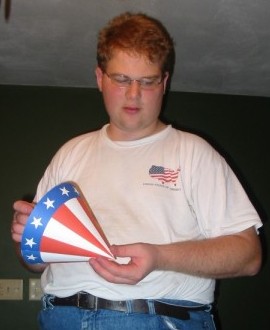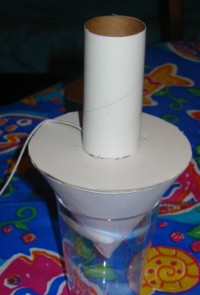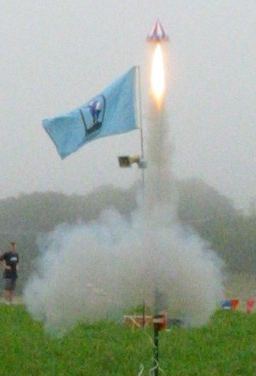Art Applewhite Rockets Cone Rocket 29mm
Art Applewhite Rockets - Cone Rocket 29mm {Kit}
Contributed by Douglas Gardei
| Construction Rating: | starstarstarstar_borderstar_border |
| Flight Rating: | starstarstarstarstar |
| Overall Rating: | starstarstarstar_borderstar_border |
| Manufacturer: | Art Applewhite Rockets  |
Brief:
Cone rocket that sports a 29mm motor mount.
 Construction:
Construction:
The 29mm Cone rocket contains a 29mm motor tube, which loosely fits inside a larger diameter tube, that is used as the Cone's center tube. An elastic cord is included for recovery. Two pieces of foam board are used to make the centering rings. Several sheets of cardstock are used to make the body of the rocket. To build this rocket, you will need epoxy, white glue, scissors, and a hobby knife.
Before I started building the rocket, I went ahead and cut out everything that needed cutting. The nosecone, skirt pieces, tabs, and reinforcement straps are cut out of the poster board. A large and small centering ring is cut from the foam board. This is the trickiest part. First you cut out the inner and outer circles, making sure you also cut out the tab for the launch rod. Then you carefully cut the angle of the outer circumference. This is done by inserting the knife in a acute angle from the line, exiting just at the outer edge of the bottom of the centering ring.

Construction of the rocket starts with the nose cone of the rocket. The cone is rolled in a manner so that it forms a double-layered cone. After gluing the cone together, the very tip of the cone is filled with epoxy. This stiffens the tip of the Cone rocket, and adds weight to the nose. While the epoxy is curing in the nosecone, I took the Center tube, shock cord, and the nosecone-centering ring, and pre-assembled the internals of the nosecone. I tied a double knot to the shock cord, and held it to the center tube using the centering ring. The knot should be located on the topside of the assembly. Once the Epoxy set in the cone, I dry fitted the center tube assembly in the nose cone. I got an idea where the centering ring will go, so I applied a bead of epoxy to the center tube where the centering ring should end up, and on the inside edge of the cone, and some more in the tip of the cone for the benefit of the center tube. Then I pressed the assembly into the cone, making sure the launch lug holes are lined up, and held it together till the epoxy cured.
 Construction of the skirt of the cone starts with gluing the two halves of card stock together. Once the glue is dry, the skirt is rolled into shape and the two halves are clued together. Then reinforcement strips are glued to the inside edge of the base of the cone. Once all glue has dried, I glued the nosecone assembly into the skirt.
Construction of the skirt of the cone starts with gluing the two halves of card stock together. Once the glue is dry, the skirt is rolled into shape and the two halves are clued together. Then reinforcement strips are glued to the inside edge of the base of the cone. Once all glue has dried, I glued the nosecone assembly into the skirt.
The motor mount of the rocket consists of a length of 29mm tubing, the large centering ring cut out of the foam board, and the other end of the shock cord. The instruction says to use a tri-fold paper mount to attach the shock cord to the centering ring. I decided to use the same method of attaching the shock that I used with the nose cone with the motor mount. This time though, the knot will be located on the rear side of the centering ring.
Finishing:
The Cone rocket is pretty much ready to go as finished. They do recommend that you coat the rocket with clear coat to protect it from moisture. However, I could not find my clear coat so I had to skip that step.
Construction Rating: 3 ½ out of 5
Flight:
The first opportunity I had to fly my cone rocket occurred August 16th, 2003 at a Frontier launch in Halifax, MA. However, a Thunder Shower hit us so quick that I was unable to prevent my Cone rocket from getting damaged by water. Thankfully, Art was kind enough to send me a new skirt for my Cone Rocket. The next launch was scheduled September 6th. The launch was canceled, but that did not stop me from launching rockets with a friend. I meant to fly my Cone rocket with an E16 and F40, but as soon as I reached the launch site, I realized I forgot to grab my RMS 29/40-120 cases.
No big deal. I used a 24mm adapter and my RMS 24/40 case to launch my Cone with an E28-5T motor. Great flight, ejected after apogee. Then I launched it again with a aged G54-6W motor - using a Quickburst igniter - Great Flight!!! Ejection occurred after apogee. This would be a great rocket to fly with those Ellis G35 motors. To bad I am all out of them :(.
Flight Rating: 5 out of 5
Summary:
Overall, the 29mm Cone rocket from Art Applewhite is a fun rocket to build and to fly. It is fairly easy to build, no finishing required. Due to personal experience, the Clear Coat is a good idea. On September 27th, I plan to fly my Cone rocket with an E16, and maybe a F40.
Overall Rating: 3 ½ out of 5
Other Reviews
- Art Applewhite Rockets Cone Rocket 29mm By Moira Jean Whitlock
Brief: Single staged conical rocket that flies on 29mm motors and recovers by a combination of tumble recovery and shock cord. The light weight of the rocket makes a streamer or parachute unnecessary. Construction: The kit comes in a sealed plastic envelope with two body tubes, namely, a 5 inch length of 29mm motor tubing and 5 inches of BT55 motor mount tubing. The rocket has no ...
 |
 |
Flights
Sponsored Ads
 |
 |




![Calling Marshall Applewhite [Explicit] Calling Marshall Applewhite [Explicit]](https://m.media-amazon.com/images/I/51MeUaBWTkL._SL500_.jpg)





